Table of Contents
Table of Contents
Managed Service Providers (MSPs) are entrusted with the important task of orchestrating complex networks, ensuring uninterrupted service, and safeguarding the delicate balance between digital innovation and operational stability.
In this article, we’ll be delving into the importance of MSP Network Monitoring and the pivotal role that MSPs play in maintaining the intricate web of connections that power our interconnected world.
Picture this: a tapestry of networks, each one unique, intertwined, and essential to the functioning of diverse businesses. As an MSP, the challenge lies not only in managing these intricate networks but also in providing clients with a transparent window into the health and performance of their individual systems. This is where the concept of multi-client visibility steps onto the stage.
Throughout this guide, we will traverse the landscape of MSP network monitoring, exploring its significance, methodologies, and the tools that empower MSPs to not only monitor the health of their client's networks but also to deliver real-time insights and proactive solutions. We will unravel the layers of complexity surrounding multi-client visibility, shedding light on how it transforms the MSP-client relationship from mere service provider to strategic partner.
So, whether you're an MSP aiming to enhance your network management prowess or a business owner curious about the intricate dance of network monitoring, join us as we navigate the intricacies of multi-client visibility in the world of MSP network monitoring.
MSP Network Monitoring refers to the practice of monitoring and managing the computer networks of multiple clients by Managed Service Providers (MSPs). Managed Service Providers are external entities that offer a range of IT services to businesses, organizations, or individuals. These services can include network management, cybersecurity, cloud computing, data backup, and more.
Network monitoring involves the continuous surveillance of a network's health, performance, and security. MSPs use specialized tools and software to monitor various aspects of the network, such as:
- Device Status: Monitoring the operational status of network devices like routers, switches, servers, and endpoints to ensure they are functioning properly.
- Bandwidth Utilization: Tracking the amount of data being transmitted through the network to identify congestion or potential bottlenecks.
- Network Traffic: Analyzing the flow of data across the network to detect abnormal patterns or potential security breaches.
- Application Performance: Assessing the responsiveness and efficiency of applications running on the network to ensure optimal user experience.
- Security Threats: Monitoring for unauthorized access attempts, malware, viruses, and other security threats that could compromise the network's integrity.
- Uptime and Downtime: Keeping track of network availability and uptime to minimize downtime and disruptions.
- Alerts and Notifications: Set up network monitoring alerts and notifications that trigger when predefined thresholds or anomalies are detected, enabling prompt action and issue resolution.
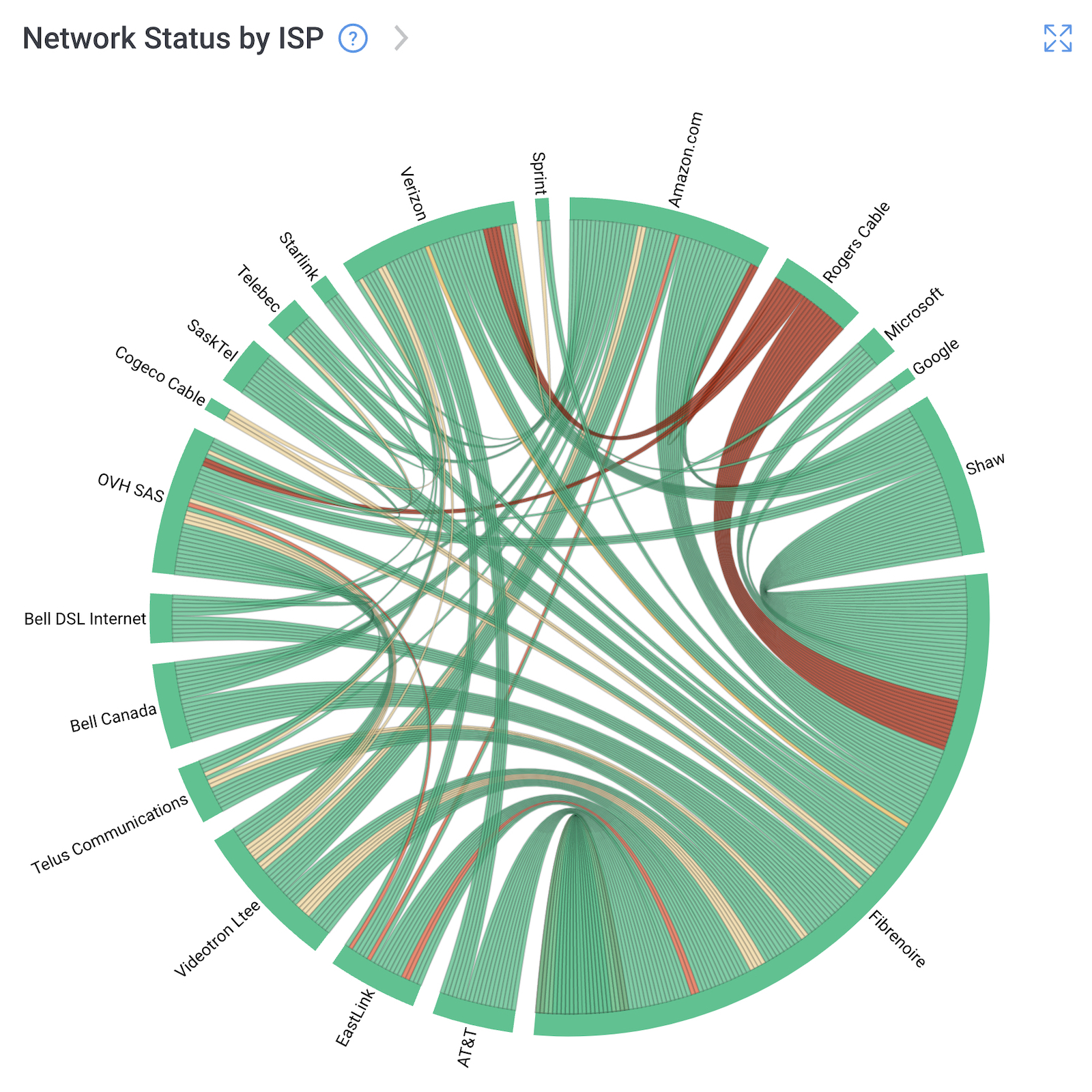

Although MSPs are only responsible for a portion of the network, if a problem occurs elsewhere on the MSP network or client network, MSPs will be the first to receive the customer’s complaint. This can cause a tireless back-and-forth game of ping-pong between customers, the MSP, and the ISP, as they try to identify where the problem is coming from and who is responsible.
But MSP Network Monitoring solves that issue! And offers a wide range of benefits for both Managed Service Providers (MSPs) and their clients:
- Proactive Issue Detection: MSP Network Monitoring allows for the early detection of potential network issues, such as hardware failures, software glitches, or security breaches. This proactive approach helps prevent downtime and disruptions before they impact business operations.
- Reduced Downtime: By identifying and addressing issues promptly, MSPs can significantly reduce network downtime. This translates to increased productivity, minimized revenue loss, and improved customer satisfaction for clients.
- Performance Optimization: Monitoring network performance and traffic patterns allows MSPs to identify bottlenecks, optimize resource allocation, and ensure that applications and services run smoothly, providing an optimal user experience.
- Customized Solutions: MSPs can tailor monitoring strategies to meet the unique needs of each client. This ensures that the monitoring approach aligns with the specific goals and requirements of the business.
- Resource Efficiency: Monitoring helps MSPs track resource utilization, such as bandwidth, server capacity, and storage. This information enables efficient resource allocation and cost-effective scaling as needed.
- Real-time Alerts: MSP Network Monitoring tools can generate real-time alerts and notifications when predefined thresholds are exceeded or anomalies are detected. This allows for quick action and issue resolution.
- Data-Driven Decisions: Monitoring generates valuable data and insights that can inform strategic decisions about network upgrades, optimizations, and IT investments.
- Regulatory Compliance: Many industries have specific regulations and compliance requirements related to data security and network management. MSP Network Monitoring can help businesses stay compliant by ensuring security practices and data handling procedures are in line with industry standards.
- Client Transparency: MSPs can provide clients with detailed reports and dashboards showcasing network performance, security, and other relevant metrics. This transparency fosters trust and collaboration between MSPs and their clients.
Overall, MSP Network Monitoring empowers businesses with reliable, secure, and high-performing networks, enabling them to navigate the complexities of the digital landscape with confidence while unlocking opportunities for growth and innovation.
Are you tired of the ping-pong blame game, ready to offer your clients unparalleled transparency, and eager to elevate your reputation as a proactive Managed Service Provider? Look no further than Obkio's cutting-edge Network Monitoring tool.

With Obkio, you'll gain real-time insights into network performance, effortlessly detect and address issues, and empower your clients to take control of their network troubleshooting. Put an end to the finger-pointing and unlock a new era of collaboration and problem-solving.
Experience the difference of MSP Network Monitoring powered by Obkio. Join the ranks of industry leaders who trust our state-of-the-art platform to enhance client relationships, boost operational efficiency, and solidify their position as technology trailblazers.
Don't let network challenges hold you back. Take the first step towards seamless network management with Obkio. Sign up for a free trial today and discover the future of MSP Network Monitoring.
- 14-day free trial of all premium features
- Deploy in just 10 minutes
- Monitor performance in all key network locations
- Measure real-time network metrics
- Identify and troubleshoot live network problems

Businesses of all sizes are constantly seeking ways to streamline their operations, enhance efficiency, and stay ahead of the competition. As organizations increasingly rely on technology to drive their success, the role of Managed Service Providers (MSPs) has become not only prominent but indispensable.
MSPs have emerged as the linchpin connecting businesses with the complex world of information technology, ensuring that their digital landscapes remain robust, resilient, and ready to navigate the challenges of today's interconnected ecosystem.
At the heart of every successful business lies a network – a digital nervous system that facilitates communication, data transfer, and the smooth execution of operations. However, managing this network can be a daunting task, especially as it grows in complexity and scale. This is where MSPs step in as the true architects of technology excellence.
MSPs are the behind-the-scenes magicians who design, build, and maintain the intricate web of networks that power modern businesses. They possess a wealth of technical expertise, offering a comprehensive suite of services ranging from network setup and configuration to ongoing maintenance and troubleshooting. With their support, organizations can offload the burden of IT management, enabling them to focus on their core competencies and strategic initiatives.
In any modern business, downtime can translate into significant financial losses and reputational damage, the role of MSPs in ensuring uninterrupted operations cannot be overstated. These technology stewards implement robust monitoring and management practices that allow them to detect and address potential issues before they escalate into full-blown crises.
This proactive approach minimizes disruptions and keeps businesses running smoothly, even in the face of unforeseen challenges.
As businesses accumulate and rely on ever-increasing volumes of sensitive data, the importance of robust cybersecurity measures cannot be emphasized enough. MSPs serve as guardians of data security, implementing best-in-class practices to safeguard valuable information from cyber threats.
They design and enforce security protocols, conduct regular audits, and stay abreast of the latest cybersecurity trends to ensure that their clients' digital assets remain shielded from harm.
Perhaps the most remarkable aspect of the MSP's role is its contribution to fostering growth and innovation. By taking on the responsibility of managing and optimizing technology infrastructure, MSPs free up organizations to focus on strategic initiatives, product development, and customer engagement. This enables smoother product management processes, helping teams stay aligned and productive in achieving their goals.
This empowerment opens doors to new possibilities, allowing businesses to explore innovative avenues and seize opportunities that drive their evolution in a rapidly changing marketplace.
When it comes to networking monitoring, MSPs have a unique set of needs. They need to monitor their own network performance to ensure that their services are up and running for their clients, and they also need to monitor their network performance between their network and their clients’ networks to identify and troubleshoot network problems.
To do that, they need the right monitoring solutions tailored to their needs.
Enter Obkio’s MSP Network Monitoring Solution, tailored to help MSPs quickly find and fix network problems in MSP networks and client networks.
If you’re an MSP, you’re at the right place. We’re going to teach you how to deploy Obkio’s MSP Network Monitoring tool in minutes, to get visibility of your MSP network, and each of your client networks. Let’s get started.
Experience the difference of MSP Network Monitoring powered by Obkio.
With Obkio, you'll gain real-time insights into both your MSP network performance and the network performance of every individual MSP client. Effortlessly detect and address issues, and empower your clients to take control of their network troubleshooting. Put an end to the finger-pointing and unlock a new era of collaboration and problem-solving.
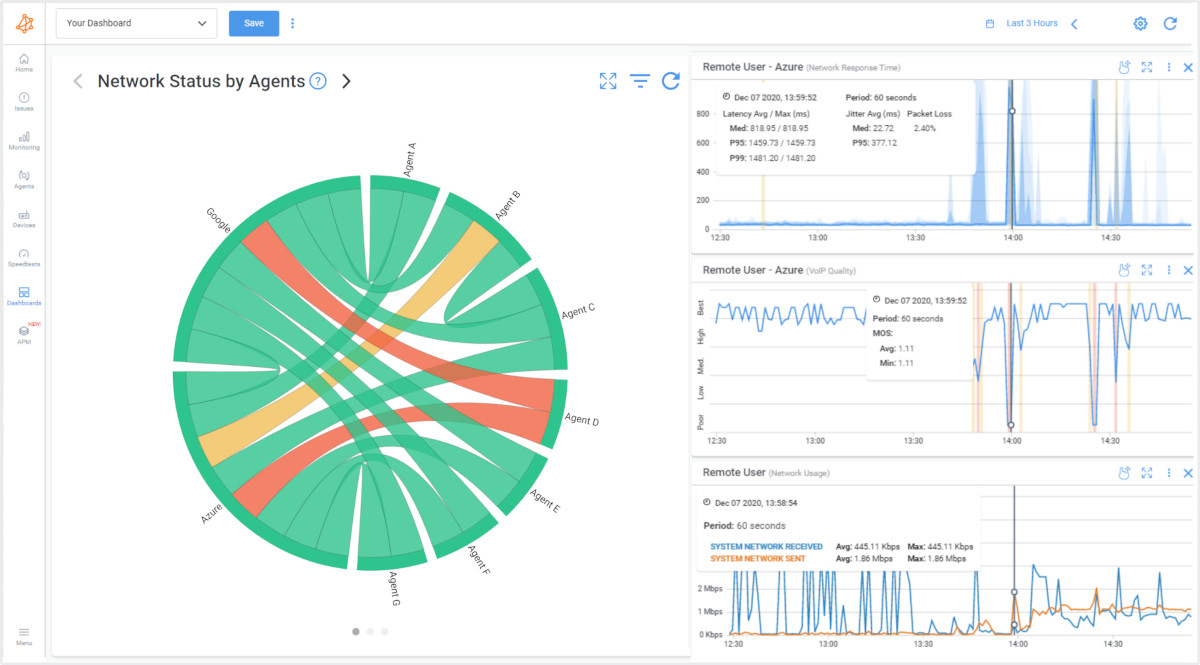
- Enhanced Client Relations: Strengthen client trust and collaboration by providing transparent, real-time visibility of both your MSP network performance and individual client network performance.
- Proactive Issue Resolution: Detect and address network issues before they impact your clients, minimizing downtime and disruptions.
- Customized Insights: Tailor monitoring reports to match each client's unique needs and preferences, showcasing your dedication to their success.
- Time and Cost Savings: Streamline network management, reduce manual interventions, and allocate resources more efficiently.
- Reputation Amplification: Establish yourself as a forward-thinking MSP who empowers clients and is always one step ahead of network challenges.
Deploy Obkio and start monitoring network performance in just 10 minutes!

Obkio monitors network performance using a unique software, called Monitoring Agents. The Monitoring Agents are a unique software installed at every end of your distributed network to monitor every decentralized location, and to identify network issues happening in every location, application, or over the Internet.
They exchange Synthetic Traffic between each other every 500ms to monitor performance between every single network location like:
- Branch offices
- Head offices
- Data centers
- Clouds
- And the Internet
This distributed network monitoring strategy is ideal for MSPs looking to monitor network performance for multiple network locations, including customer networks. To harness the full potential of Obkio's Network Monitoring tool, MSPs initiate their journey by deploying Monitoring Agents within their local network infrastructure.
- Local Agents (Windows, MacOS, Linux, Hardware) are installed at key network locations such as branch offices, data centers, and remote locations to monitor performance.
- Public Monitoring Agents are Agents installed in Service Provider networks (like AWS, Google, and Azure). They can be used to monitor the performance of any branch externally towards the Internet (without passing through the head office).
Some MSPs also choose to host their own Public Monitoring Agents, allowing their clients to monitor network performance up to the MSP network infrastructure, with pre-deployed Agents.
Key Steps in Deploying Monitoring Agents:
- Strategic Placement: Choose strategic locations within your network where Monitoring Agents will be deployed. These locations should offer comprehensive coverage and insight into network segments that require monitoring.
- Agent Installation: Install Obkio's Monitoring Agents in the selected locations. This process is straightforward and well-guided, ensuring a seamless setup even for non-technical users.
- Continuous Surveillance: Once deployed, Monitoring Agents continuously monitor network traffic, latency, bandwidth utilization, and other critical performance indicators. This surveillance operates in the background, providing real-time data without interrupting your network operations.
- Data Collection and Analysis: The data collected by Monitoring Agents is meticulously analyzed by Obkio's advanced algorithms, generating comprehensive performance reports and visualizations. These insights offer a clear picture of network health, enabling you to identify issues, optimize resources, and make informed decisions.
- Ensuring Service Excellence: By monitoring your network with precision, Monitoring Agents enable you to ensure the seamless functioning of your services. Timely identification of performance hiccups empowers you to address them proactively, minimizing disruptions and maintaining service excellence.
MSPs now not only have their own networks to manage, but they also need visibility of their clients’ networks to understand if service issues are happening in their networks or their clients’ networks.
But how do you navigate the complexities of client networks, pinpoint issues, and provide impactful solutions? Extend your reach by deploying Monitoring Agents across all your clients' networks.
80% of customer service calls to Service Providers are related to LAN and wireless issues on their ends. With Obkio, stop the ping-pong blame game between customers’ support teams and prove that the network is NOT the problem. So customers can look into the issue on their end, without damaging your reputation as a Service Provider.
The Path to Comprehensive Network Understanding:
- Client Network Partnership: Collaborate with your clients to seamlessly integrate Obkio's Monitoring Agents into their networks. This partnership marks a proactive step towards enhancing network performance and troubleshooting capabilities.
- Strategic Deployment: Place Monitoring Agents strategically within each client's network, mirroring the approach taken within your own infrastructure. These agents will monitor network performance from your clients' networks, extending visibility and understanding into the intricate layers of their operations.
- Client-Centric Insights: The Monitoring Agents gather invaluable data about your clients' network traffic, latency, and overall performance. This data is then translated into comprehensive reports and visualizations, offering insights that empower you and your clients to make informed decisions.
- Collaborative Troubleshooting: With a holistic view spanning from your clients' networks up to your own, you're equipped to trace the origin of network issues. This collaborative troubleshooting approach eradicates guesswork, accelerates issue resolution, and fosters a deeper sense of partnership between you and your clients.
Elevating Client Services to New Heights:
- Timely Issue Resolution: The ability to monitor network performance from your clients' perspective enables you to swiftly detect and address issues, ensuring uninterrupted operations and boosting client satisfaction.
- Precise Troubleshooting: By pinpointing the source of network challenges, you enhance your troubleshooting accuracy, leading to quicker solutions and a more efficient allocation of resources.
- Client Empowerment: Empower your clients with tangible data about their network health, enabling them to take proactive measures and collaborate more effectively in maintaining optimal performance.
- Proactive Partnership: The deployment of Monitoring Agents in your clients' networks positions you as a forward-thinking, technology-savvy partner invested in their success.
With Monitoring Agents seamlessly integrated into both your own network and your clients' networks, you embark on a transformative journey of comprehensive network understanding. Obkio's Network Monitoring tool empowers MSPs to transcend conventional boundaries, offering a level of service that is rooted in data-driven insights, strategic collaboration, and unwavering dedication to network excellence.
Deploying Obkio's Monitoring Agents within your network and your clients' networks is a significant step toward comprehensive network management. However, this journey extends beyond mere deployment. It evolves into a continuous exchange of synthetic traffic, amplifying your ability to monitor network performance across interconnected ecosystems.
With all Monitoring Agents in place, they initiate an ongoing exchange of synthetic traffic. This exchange not only monitors individual network performance but also facilitates insights into the dynamic interactions between your MSP network and your clients' networks.
- Comprehensive Performance Analysis: Synthetic monitoring offers a holistic perspective on network performance, providing insights into interconnected dependencies, bottlenecks, and performance patterns.
- Proactive Issue Detection: Continuous synthetic testing establishes a performance baseline. Deviations trigger alerts, enabling proactive issue identification and resolution.
- Collaborative Troubleshooting: Shared insights foster collaboration, leading to efficient troubleshooting, reduced blame, and quicker issue resolution.
- Informed Decision-Making: The wealth of data from synthetic traffic empowers informed decisions about network enhancements, upgrades, and resource allocation.
- Optimized Resource Utilization: Understand network traffic flows between your network and clients' networks, allowing efficient resource allocation.
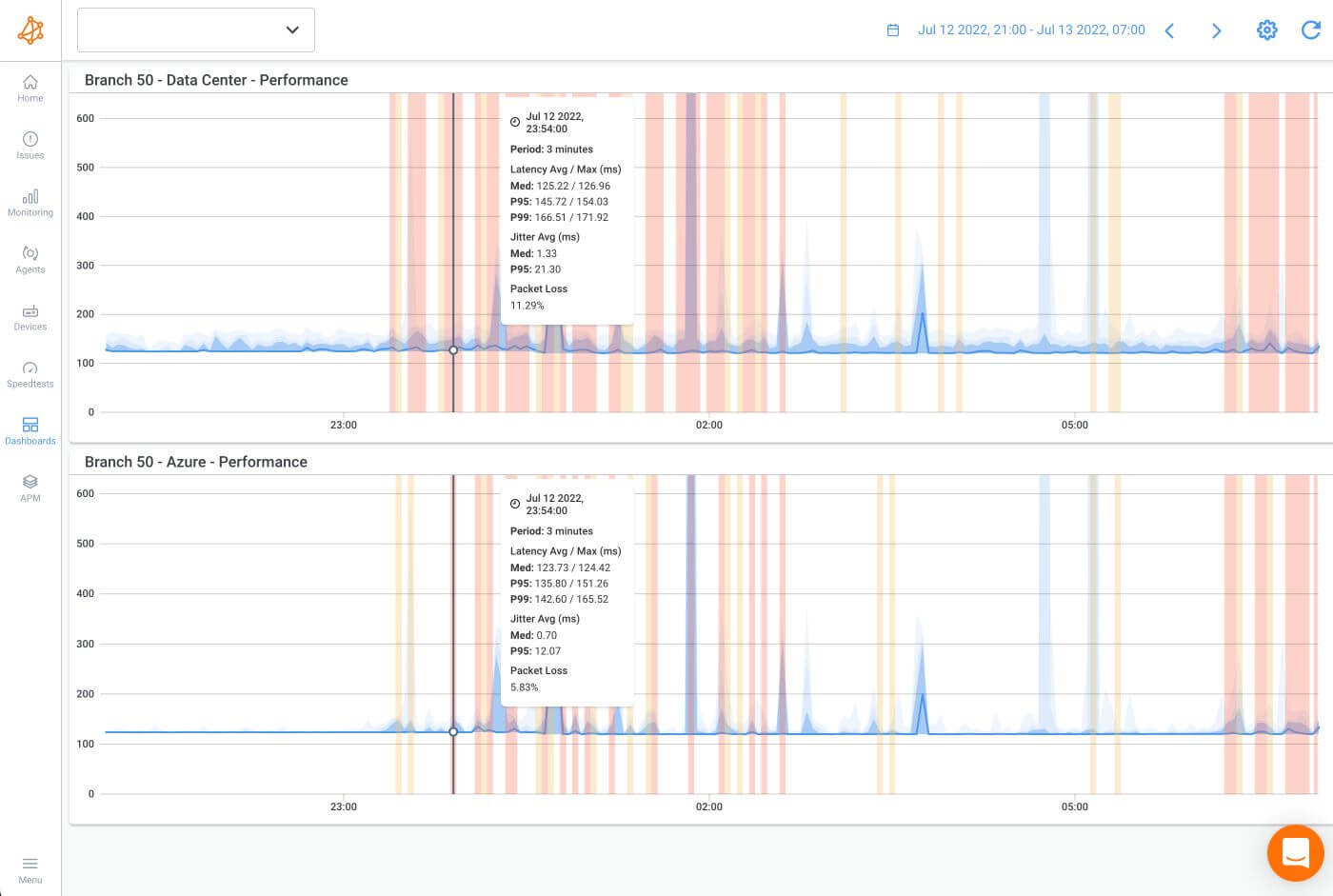

In the realm of Managed Service Providers (MSPs), a common scenario unfolds – the ping-pong blame game between customer support teams. A staggering 80% of customer service calls to Service Providers revolve around LAN and wireless issues on their ends.
The exasperating back-and-forth between clients and support teams often leads to frustration, delayed solutions, and even damage to the MSP's reputation. But MSP Network Monitoring with Obkio offers a game-changing solution that puts an end to this cycle of uncertainty.
MSP Network Monitoring acts as a reliable and impartial witness in the midst of network-related disputes. When LAN or wireless issues arise, the blame often shifts between the client's internal systems and the service provider's network.
With Obkio’s extensive MSP Network Monitoring features, MSPs can provide concrete evidence of network health and performance. Real-time data, historical trends, and detailed reports become allies that MSPs can wield to confidently demonstrate that the network is not the root cause of the problem.
Imagine the transformative power of handing your clients the tools they need to investigate issues on their end. Armed with accurate network performance insights, they can focus their troubleshooting efforts where they matter most.
MSP Network Monitoring fosters an environment of collaboration and shared responsibility. Clients appreciate the transparency and the ability to take proactive measures, while MSPs can maintain their reputation as reliable and proactive partners.
In the business world, reputation is everything. The elimination of the ping-pong blame game through MSP Network Monitoring isn't just a practical solution – it's a strategic move.
By swiftly resolving issues and providing verifiable data, MSPs can bolster their reputation as trusted technology advisors. Clients value partners who empower them with insights and collaborate on solutions, ultimately leading to stronger, more enduring relationships.


In the dynamic world of Managed Service Providers (MSPs), achieving network excellence requires more than just a cursory glance. It demands a keen understanding of critical network metrics that unveil the intricate layers of performance, reliability, and security.
As an MSP, your ability to harness and interpret these metrics is your compass to steer networks toward success. In this section, we delve into the essential network metrics that form the foundation of MSP Network Monitoring.
- Latency: Latency measures the delay in data transmission between two points on a network. High latency can lead to slow application response times and reduced user satisfaction.
- Packet Loss: Packet loss indicates the percentage of data packets that fail to reach their destination. Excessive packet loss can lead to data retransmissions, impacting network performance.
- Jitter: Jitter measures the variability in packet delay. Consistent jitter is important for ensuring smooth and predictable data transmission, especially for real-time applications like VoIP and video conferencing.
- Bandwidth Utilization: This metric tracks the amount of data transmitted over the network compared to its capacity. Monitoring bandwidth utilization helps identify congestion and plan for capacity upgrades.
- Network Traffic: Analyzing the volume and patterns of network traffic helps identify peak usage times, potential bottlenecks, and trends that could impact network performance.
- Device Health: Monitoring the status and availability of network devices (e.g., routers, switches, servers) using SNMP Monitoring or Network Device Monitoring helps ensure they are operational and performing optimally.
- Application Performance: Tracking the responsiveness and efficiency of applications running on the network helps ensure a positive user experience and troubleshoot performance issues.
- Uptime and Downtime: Measuring network availability and uptime of network services helps evaluate network reliability and identify potential areas for improvement.
- Response Time: Response time measures the time it takes for a system or application to respond to a user's request. Slow response times can impact user productivity and satisfaction.
- Throughput: Throughput measures the amount of data that can be transmitted over the network in a given time. It helps assess network capacity and performance.
- DNS Resolution Time: Monitoring DNS resolution time or, the time it takes to resolve domain names to IP addresses, helps ensure efficient web browsing and application access.
- CPU and Memory Usage: Measuring CPU usage and memory resources on network devices helps identify potential performance bottlenecks.
- Error Rates: Tracking error rates, such as CRC errors or input/output errors, helps identify network hardware issues that could impact performance.
- Quality of Service (QoS): QoS metrics help ensure that critical applications receive the necessary network resources and prioritize traffic accordingly.
- Network Topology Changes: Detecting changes in the network topology helps maintain accurate network documentation and identify any unauthorized modifications.
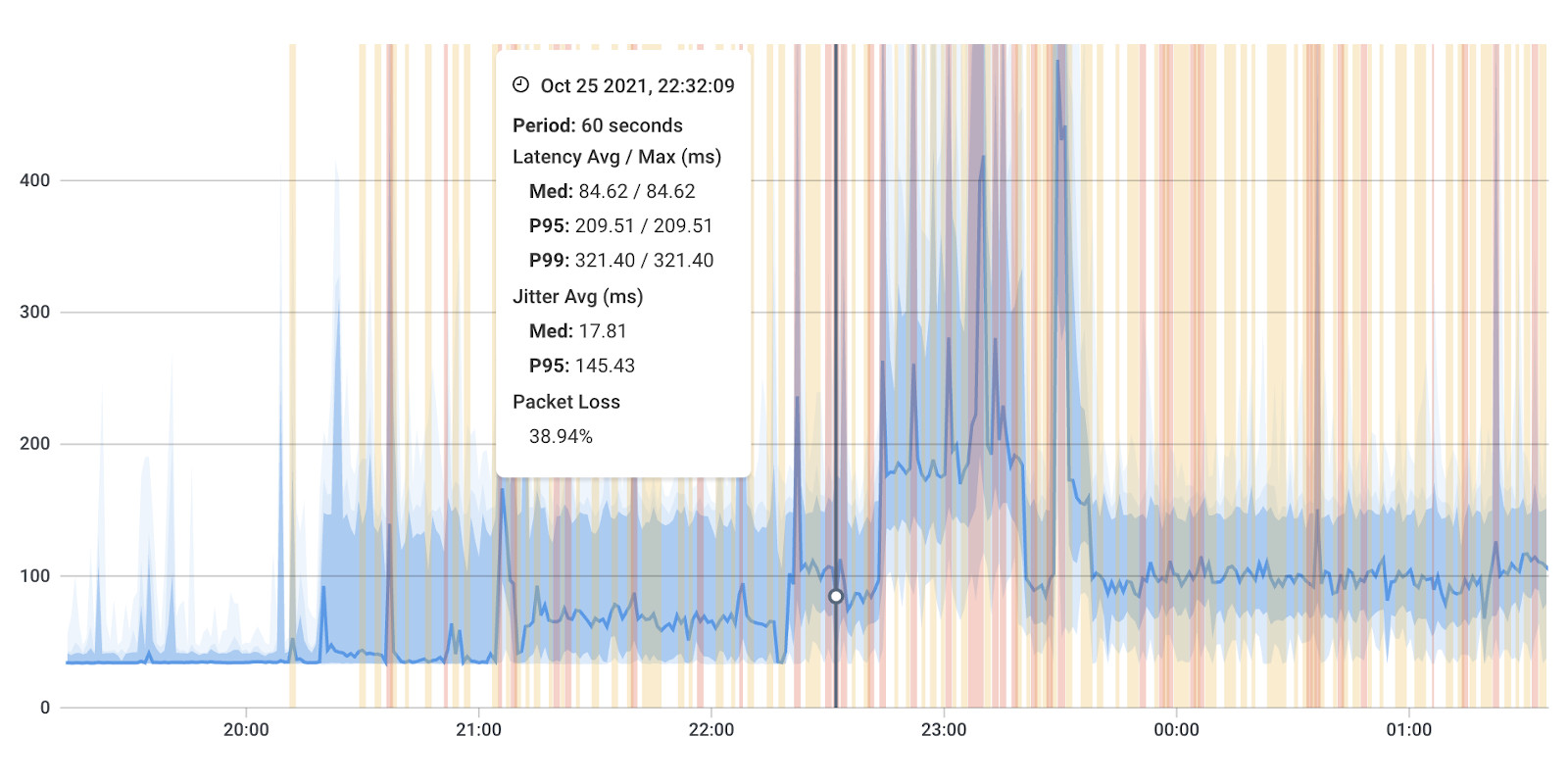
These metrics provide MSPs with a comprehensive view of network performance, enabling them to proactively detect issues, optimize resources, and deliver a high-quality experience for their clients.
In the realm of Managed Service Providers (MSPs), a shift has occurred that's transforming how networks are managed, problems are solved, and partnerships are forged. This shift revolves around the concept of multi-client visibility, a fundamental change that's impacting the landscape of MSP network monitoring.
Multi-client visibility goes beyond the technical aspects of network management. It's about opening a channel of collaboration between MSPs and their clients. This approach enables MSPs to share real-time insights into network performance, allowing both parties to work together on addressing issues and optimizing network operations. By creating a unified view of network health, MSPs and clients can communicate more effectively and make informed decisions that align with business goals.
In the traditional MSP model, troubleshooting often began when issues arose. Multi-client visibility flips this script. By centralizing network monitoring across multiple clients, MSPs can identify potential problems before they disrupt operations. This proactive approach minimizes downtime, enhances network reliability, and ultimately contributes to a smoother experience for clients.
Every client has unique network requirements and priorities. Multi-client visibility enables MSPs to provide customized insights and reports that cater to each client's specific needs. This personalization strengthens the partnership between MSPs and clients, as it demonstrates a deep understanding of individual business objectives and a commitment to delivering value that goes beyond a one-size-fits-all approach.
At its core, multi-client visibility is about looking beyond the boundaries of individual networks and seeing the bigger picture. MSPs gain a comprehensive understanding of how networks interact, the dependencies between systems, and trends that impact multiple clients. This broader perspective empowers MSPs to offer strategic guidance, optimize network resources, and support clients in navigating the ever-evolving digital landscape.
Multi-client visibility is more than a buzzword; it's a mindset shift that's shaping the future of MSP network monitoring. As MSPs embrace this approach, they're not just managing networks – they're fostering partnerships, driving collaboration, and providing a level of service that resonates with clients' needs. With multi-client visibility, MSPs are charting a course toward network management that's not only effective but also deeply connected to the success of their clients' businesses.
In the journey of MSP network monitoring, multi-client visibility is a guiding principle that offers a fresh perspective on how networks are managed and how relationships are cultivated. By prioritizing collaboration, proactive solutions, and tailored services, MSPs equipped with multi-client visibility are setting a new standard for network excellence. This approach isn't just about technology; it's about people, partnerships, and a shared commitment to achieving the best possible network performance for all parties involved.

Managed Service Providers (MSPs) employ Network Monitoring for a variety of use cases to ensure the optimal performance, security, and reliability of their clients' networks. Here are some common MSP Network Monitoring use cases:
- Proactive Issue Detection and Resolution: MSPs use Network Monitoring to identify and address network issues before they impact clients' operations. By setting up alerts for abnormal metrics such as high latency or packet loss, MSPs can respond swiftly and resolve problems proactively.
- Capacity Planning: Monitoring network traffic and bandwidth utilization helps MSPs anticipate capacity requirements. By analyzing trends and historical data, MSPs can recommend necessary upgrades or adjustments to accommodate growing network demands.
- Security Monitoring: MSPs can detect and mitigate security threats by monitoring network traffic for anomalies, unauthorized access attempts, and suspicious behaviour. This helps protect clients' sensitive data and ensures compliance with security regulations.
- Application Performance Optimization: Network Monitoring allows MSPs to assess how applications are performing over the network. They can identify bottlenecks, optimize traffic routing, and ensure consistent application responsiveness.
- SLA Compliance Monitoring: MSPs can use Network Monitoring to track and report on SLA compliance. SLA monitoring involves monitoring key performance metrics to ensure that the network is meeting the agreed-upon service levels.
- Multi-Client Visibility: MSPs often manage multiple clients' networks. Network Monitoring provides a centralized view of all client networks, enabling MSPs to efficiently monitor and manage various environments from a single dashboard.
- Troubleshooting and Root Cause Analysis: When network issues arise, MSPs can use Network Monitoring to analyze traffic patterns, performance metrics, and device health to pinpoint the root cause of problems and expedite troubleshooting.
- Network Configuration Management: Monitoring changes in network configurations helps MSPs maintain network stability and security. Any unauthorized or unintended configuration changes can be quickly identified and rectified.
- Vendor Performance Assessment: MSPs can use Network Monitoring to assess the performance of third-party vendors or service providers who contribute to the overall network ecosystem. This ensures that vendors meet their obligations and deliver promised services.
- Disaster Recovery and Business Continuity: In the event of a network failure or disaster, MSPs can rely on Network Monitoring to assess the extent of the impact and guide disaster recovery efforts to minimize downtime and maintain business continuity.
- Client Reporting and Communication: MSPs can generate detailed performance reports using Network Monitoring data to demonstrate the value they provide to clients. These reports can be shared during regular performance review meetings to maintain transparent communication.
- Network Documentation and Audit: Network Monitoring helps MSPs maintain accurate documentation of network configurations, changes, and performance metrics. This documentation is valuable for network audits, compliance requirements, and future planning.
- Remote Troubleshooting: MSPs often manage geographically distributed clients. Network Monitoring allows them to remotely diagnose and troubleshoot network issues, reducing the need for on-site visits and minimizing downtime.
- Resource Allocation and Optimization: By monitoring resource utilization, MSPs can optimize network resources, allocate bandwidth efficiently, and ensure fair sharing of resources among different applications and users.
These use cases showcase how MSP Network Monitoring serves as a versatile tool that enables Managed Service Providers to deliver exceptional network management services, ensure client satisfaction, and drive business growth.
Learn how to perform a network audit (network performance audit) to uncover issues before they cause havoc. Uncover Obkio's Network Audit Tool.
Learn more

In the intricate dance of Managed Service Providers (MSPs) and their clients, Service-Level Agreements (SLAs) stand as pillars of commitment. These agreements define the expectations, responsibilities, and performance benchmarks that both parties agree upon. Yet, ensuring the smooth execution of SLAs in the ever-evolving landscape of network operations can be a complex undertaking.
This is where MSP Network Monitoring emerges as a powerful ally, not only in monitoring network performance but also in meeting and even exceeding the expectations set forth in service or Internet SLAs.
At its core, an SLA is a trust-building contract that outlines the level of service a client can expect and the commitments the MSP makes. It's a mutual understanding that ensures transparency, accountability, and the delivery of promised services. However, to uphold this foundation of trust, real-time visibility into network performance is essential.
MSP Network Monitoring provides a continuous stream of data, enabling both parties to have an accurate, objective assessment of network health. This transparency creates a solid basis for SLA monitoring, troubleshooting, and, ultimately, successful SLA fulfillment.
While SLAs often specify high-level performance metrics, MSP Network Monitoring allows you to dive deeper. It's not just about meeting the minimum requirements; it's about optimizing performance to enhance the client experience.
By monitoring key network metrics – such as latency, packet loss, and bandwidth utilization – MSPs can proactively detect issues, identify bottlenecks, and resolve potential disruptions or network disconnections before they impact SLA compliance. This level of vigilance enables MSPs to maintain network stability and offer clients a seamless digital experience.
In the world of SLAs, assumptions have no place. Data is the driving force that substantiates your efforts and showcases your commitment to meeting SLA targets. MSP Network Monitoring generates comprehensive reports and visualizations that provide a clear snapshot of network performance over time.
Armed with this data, you can demonstrate compliance, initiate evidence-backed discussions with clients, and collaboratively make informed decisions to address any SLA-related challenges.
While meeting SLAs is a crucial goal, surpassing expectations is the hallmark of outstanding service. MSP Network Monitoring empowers MSPs to be proactive rather than reactive. By identifying potential issues before they lead to SLA breaches, you can take swift action to prevent disruptions. This proactive approach not only safeguards your reputation but also elevates the level of service you provide. Clients recognize and appreciate the dedication to their network's reliability and performance.
Network issues, despite our best efforts, can still arise. In these instances, MSP Network Monitoring becomes a central tool for collaboration. Both MSP and client can access real-time insights, pinpoint the root cause of an issue, and work together on resolution strategies. This joint effort not only strengthens the MSP-client relationship but also showcases the true value of having a trusted partner who is dedicated to maintaining SLA compliance.
Leveraging MSP Network Monitoring to monitor and meet SLAs isn't just a technical consideration; it's a strategic imperative. It's about fostering transparency, upholding commitments, and delivering a level of service that instills confidence in your clients.
Learn about SLA monitoring & reporting using Network Monitoring to measure network, service performance, user experience & understand if SLAs are being met.
Learn more

By combining the power of data-driven insights, proactive monitoring, and collaborative troubleshooting, MSP Network Monitoring becomes more than a tool – it becomes a catalyst for exceeding expectations, building lasting partnerships, and ensuring that SLAs are not merely met, but truly valued.
To show you how MSPs can really use MSP Network Monitoring, let’s go over an example of a case study.
If you’re looking for some real case study examples, check out some of Obkio’s case studies with real MSPs:
- bravad TI VoIP End-User Network Monitoring Case Study
- Amplisys VoIP and End-User Network Monitoring Use Case
- ThinkTel Network Assessment for UC Deployment Case Study
- BeeVox Network Monitoring Case Study for Service Providers
Imagine an MSP named TechNetPro that provides IT services to various businesses. One of TechNetPro's clients, a growing e-commerce company called eZCommerce, has a critical SLA that guarantees a minimum of 99.9% network uptime to ensure their online store remains accessible at all times.
TechNetPro deploys Obkio’s Network Monitoring tool and Monitoring Agents within eZCommerce's network infrastructure, strategically placed to monitor key network segments, servers, and critical applications. These agents continuously gather data on metrics like latency, packet loss, throughput, jitter .
Through Obkio’s MSP Network Monitoring platform, TechNetPro gains real-time insights into eZCommerce's network performance. They receive alerts if any metric deviates from normal thresholds. For instance, if there's a sudden increase in latency, TechNetPro is notified immediately.
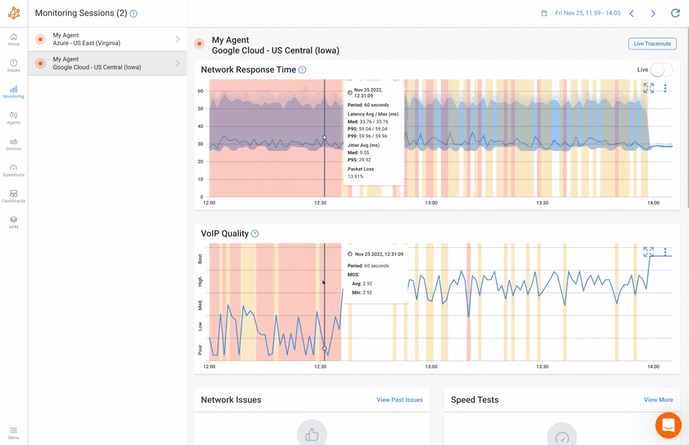

One day, TechNetPro received an alert indicating a significant spike in latency between eZCommerce's web server and its database server. Recognizing the potential impact on user experience and e-commerce operations, TechNetPro's team quickly investigates.
Using the historical data collected by the Monitoring Agents, TechNetPro identifies that the latency increase occurred during a peak traffic time. They determine that additional server resources are needed to handle the surge in user activity.
TechNetPro promptly contacts eZCommerce with the findings and recommends scaling up server capacity before any performance degradation affects users.
eZCommerce's IT team appreciates TechNetPro's proactive approach and promptly increases server capacity. The latency issue is resolved before it impacts the SLA. Both teams review the data together, discussing the issue, its resolution, and steps taken to prevent future occurrences. This collaborative approach strengthens the MSP-client relationship.
TechNetPro compiles a detailed report using the network performance data collected during the incident, including screenshots of Obkio’s dashboards, reports, and Visual Traceroute results.
They provide eZCommerce with evidence of their commitment to SLA compliance and their proactive response. The report showcases the incident, the steps taken, and the resolution achieved.
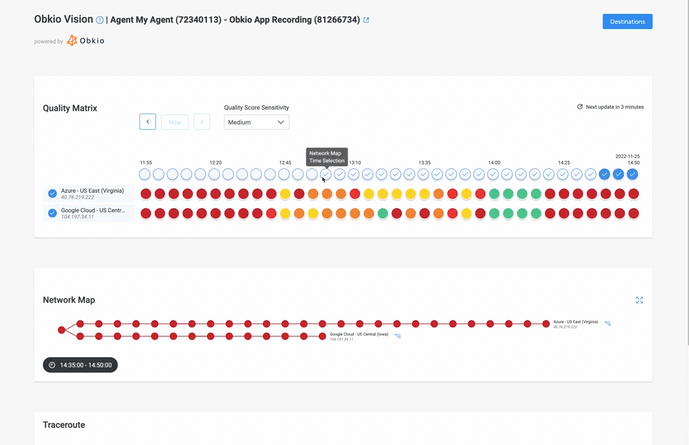
TechNetPro's proactive monitoring and swift response not only prevented a potential SLA breach but also ensured uninterrupted service for eZCommerce's customers. The incident demonstrated the power of MSP Network Monitoring in maintaining SLA commitments and fostering a strong partnership between TechNetPro and eZCommerce.
In this example, MSP Network Monitoring enabled TechNetPro to deliver on its SLA promise by proactively identifying and resolving network issues. This approach not only safeguards the client's business operations but also reinforces TechNetPro's reputation as a reliable and proactive Managed Service Provider.
The landscape of network monitoring has undergone a remarkable evolution, propelled by technological advancements and the ever-growing complexity of modern networks. From traditional SNMP (Simple Network Management Protocol) to cutting-edge Artificial Intelligence (AI) solutions, the monitoring techniques available to Managed Service Providers (MSPs) have expanded and diversified, enabling more precise, proactive, and insightful management of network performance.
In this article, we showed you how to deploy MSP Network Monitoring with Obkio’s Network Monitoring tool, which includes some of the techniques we mentioned below. But let’s go over some more techniques in detail.
SNMP, a time-tested protocol, has long served as a foundational tool for monitoring network devices. It provides a standardized way to collect and organize data from various network devices and equipment, allowing MSPs to monitor device health, track bandwidth utilization, and receive alerts for predefined events. SNMP, with its broad compatibility, remains a reliable choice for basic network monitoring needs.
If you’re MSP is looking to use SNMP, we recommend opting for a more comprehensive Network Monitoring tool, like Obkio, which includes SNMP Monitoring features in its solution. This way, you can monitor the performance of network devices, as well as other components of network performance.
Monitoring network devices is only one part of network monitoring, and may not give you the whole picture in itself.
Learn about what SNMP monitoring is & how to use it to monitor performance of networking devices like firewalls, routers, switches and wifi access points.
Learn more

Flow-based monitoring offers a high-level view of network traffic patterns. Using technologies like NetFlow or sFlow, MSPs can capture data about communication between devices, applications, and users. This technique helps identify top talkers, bandwidth hogs, and anomalies in network behaviour.
Flow-based monitoring enhances capacity planning, optimizes resource allocation, and aids in detecting security threats.
When granular insights are essential, packet-level analysis comes into play. This technique involves capturing and analyzing individual data packets traversing the network. By examining packet contents, MSPs can diagnose specific issues, identify the root cause of network problems, and optimize performance for critical applications.
Keep in mind that, because packet capture involves capturing real-user traffic, some clients may not
Synthetic traffic generation involves creating simulated network traffic to test and monitor network performance. Synthetic Monitoring helps assess how the network behaves under different conditions, such as increased user activity or application demands. By generating controlled scenarios, MSPs can proactively address potential bottlenecks and ensure optimal performance during peak times.
Obkio’s Network Monitoring tool uses synthetic monitoring to monitor network performance so it doesn’t need to capture real-user traffic. This ensures that no privacy or security laws are broken when monitoring
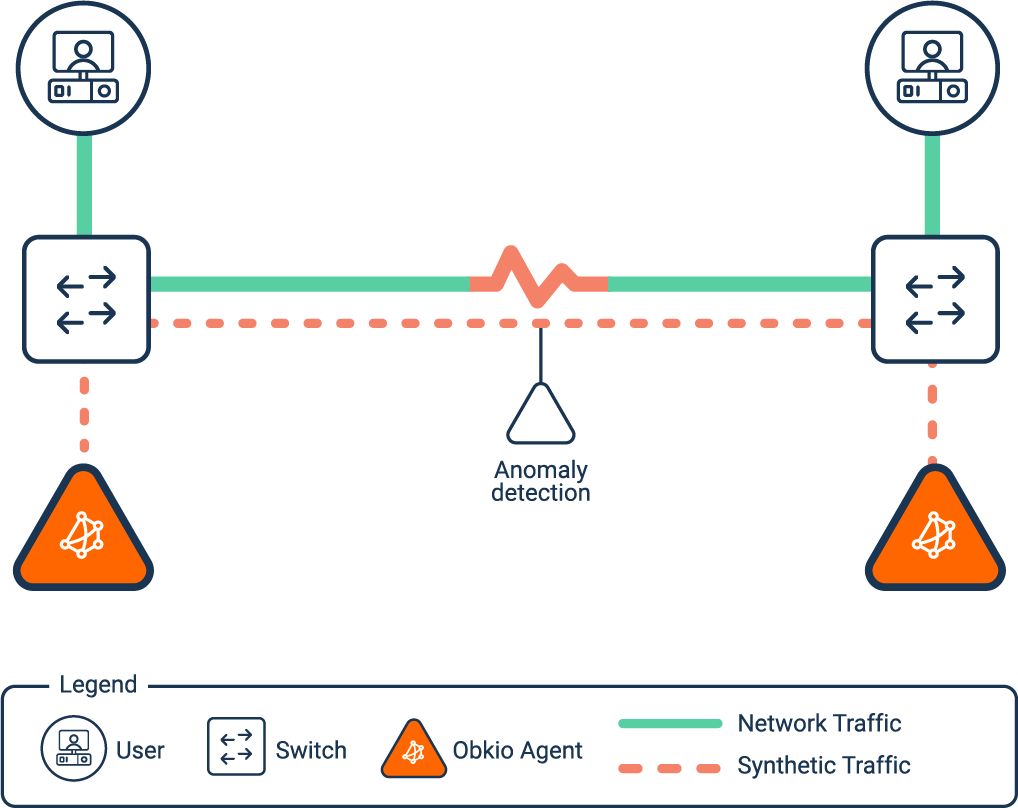
The rise of AI and machine learning has introduced a paradigm shift in network monitoring. These technologies analyze vast amounts of data to identify patterns, predict future behaviour, and detect anomalies that might go unnoticed through traditional methods. MSPs can leverage AI-driven insights to anticipate network issues, optimize resource allocation, and enhance overall network performance.
As businesses increasingly adopt cloud services, cloud network monitoring has gained prominence. MSPs can monitor networks that span on-premises infrastructure and cloud environments. This technique offers scalability, flexibility, and centralized management, enabling MSPs to adapt to dynamic network architectures.
At the heart of network operations are end users. Monitoring techniques that focus on end-user experience provide MSPs with insights into application responsiveness, load times, and overall satisfaction. By prioritizing the user perspective, MSPs can use end-user experience monitoring to align network performance with business goals and user expectations.
The array of monitoring techniques available to MSPs offers a palette of options, each suited for different use cases and objectives. The key lies in selecting the right technique or combination of techniques that align with your clients' needs, network complexity, and the level of visibility required.
As the demands of network management continue to evolve, MSPs have the opportunity to blend these techniques using a comprehensive Network Monitoring tool and stay at the forefront of proactive, efficient, and effective network monitoring.


In the intricate world of Managed Service Providers (MSPs), the responsibility for network management extends far beyond the confines of their immediate domain. While an MSP may be accountable for specific portions of a network – whether within their own infrastructure or across diverse client networks – the consequences of network issues often ripple beyond these boundaries. A seemingly isolated problem can trigger a cascade of challenges that reverberate through the entire network ecosystem.
Picture this scenario: A disruption occurs in a remote corner of the network, far from the MSP's primary domain. Despite the distance, the MSP finds themselves on the frontline of the troubleshooting battlefield. Why? Because if a problem arises anywhere within the network – whether within the MSP's scope of responsibility, within a client's network, or even beyond – they are often the first to receive the customer's complaint.
This is where the tireless game of ping-pong begins, a relentless back-and-forth between customers, the MSP, and even Internet Service Providers (ISPs). The spotlight is on the MSP, with fingers pointing their way as the initial point of contact. Each party seeks answers, and each party seeks resolution, but the labyrinthine nature of network infrastructures often obscures the path to clarity.
The challenge of identifying the root cause of network issues is often also a question of, who is responsible for solving the issue. The issue might stem from the client's internal network, an external ISP, a hardware glitch, or even a combination of factors across multiple network layers.
Yet, the MSP is often the beacon of accountability, a role that can be both a testament to their expertise and an unfair burden.
Enter MSP network monitoring as a guiding light through this labyrinth of troubleshooting. MSP Network Monitoring, with its arsenal of real-time insights and data-driven clarity, emerges as a potent ally in overcoming the challenges of identifying problem sources.
By deploying Monitoring Agents strategically across the network landscape, MSPs gain the power to monitor traffic, analyze performance metrics, and pinpoint anomalies, regardless of where they originate.
Imagine this: An issue arises, triggering alarms on the MSP Network Monitoring dashboard. Swiftly, the MSP can access comprehensive data, drill down into performance metrics, and even assess traffic patterns.
Armed with this intelligence, they can engage in informed discussions with clients and ISPs alike, armed with evidence-backed insights that transcend the finger-pointing game.
Network monitoring, in this context, becomes more than a technical tool; it becomes a catalyst for collaboration, a unifying force that brings MSPs, clients, and ISPs together. Instead of a fragmented blame game, MSP Network Monitoring nurtures an environment of shared understanding.
Together, stakeholders traverse the intricate network landscape, analyzing data, troubleshooting, and working collaboratively toward swift resolutions.
As we bring our exploration of MSP Network Monitoring to a close, it's evident that the landscape of network management has evolved into a complex tapestry of challenges and opportunities. The role of Managed Service Providers (MSPs) has never been more critical, as businesses rely on their expertise to navigate the digital seas with confidence.
Amidst this dynamic environment, the implementation of MSP Network Monitoring emerges as a beacon of innovation, a guiding star that illuminates the path to success.
In the constellation of Network Monitoring solutions, Obkio shines brightly as an exceptional choice. Its suite of tools equips MSPs with the arsenal needed to proactively monitor, troubleshoot, and optimize networks.

From its versatile Monitoring Agents to the AI-driven insights it offers, Obkio empowers MSPs to go beyond traditional boundaries, revolutionizing the way networks are managed.
Imagine a world where network issues are detected before they cast a shadow, where troubleshooting transforms from a guessing game to an informed quest, and where clients experience unprecedented satisfaction. This world is not a distant dream – it's the reality that Obkio helps MSPs create.
By embracing Obkio's Network Monitoring, you're not just adopting a tool; you're embarking on a journey toward network excellence. You're equipping yourself with the means to exceed SLA expectations, collaborate seamlessly with clients, and pioneer a new era of network management.
Are you ready to embark on this transformative journey? Discover the power of Obkio's Network Monitoring and unlock a new level of network management excellence. Your clients' networks deserve nothing less, and the future of your MSP endeavours awaits.



























 Obkio Blog
Obkio Blog









